Fig. 5.
Changes in the distribution of TJ-protein occludin and spermatid polarity in the seminiferous epithelium after knockdown of Scribble complex components by RNAi in adult rat testes in vivo. Rats were treated with corresponding siRNA duplexes to silence different components of the Scribble complex vs. nontargeting controls. Control, Scribble-silenced, Lgl2-silenced, and Scribble/Lgl2/Dlg1 triple-silenced testes were immunostained for Scribble (panel A, green) and occludin (panel A, red) using frozen sections from rats 3 d after the last siRNA transfection mix injection. A, In stage VIII tubules, the signals of Scribble in the epithelium were considerably weakened in Scribble single- and SLD triple-silenced (but not in Lgl2 single-silenced group) groups vs. controls (Ctrl). The signal of occludin in Scribble single-silenced tubules was similar to controls; however, it became more intense in Lgl2 single-silenced and SLD triple-silenced tubules vs. control. Nuclei were stained with DAPI (blue). The boxed area in micrographs in the DAPI panel was enlarged and shown in insets. White arrowheads denote misoriented spermatids with incorrect polarity, only found in SLD triple-silenced group. Scale bar, 80 μm, which applies to all other micrographs; scale bar in inset, 20 μm, which applies to all other insets. B and C, Semiquantitative analysis of data shown in panel A and in Supplemental Fig. 5. Fluorescence intensity of Scribble and occludin in the epithelium was quantified by ImageJ 1.44I in each treatment group vs. control in stage VIII (B) or stage V–VI (C) tubules. The signal intensity of Scribble in the control group was arbitrarily set at 1. At least 50 staged tubules were randomly selected from three rats and quantified. Each bar, mean ± sd of n = 3 rats. *, P < 0.05; **, P < 0.01.

